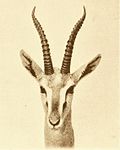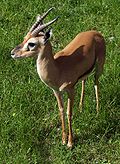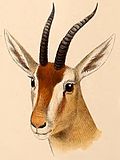| Eudorcas | |
|---|---|
 | |
| Thomson's gazelle - Serengeti region of Kenya and Tanzania | |
| Scientific classification | |
| Kingdom: | Animalia |
| Phylum: | Chordata |
| Class: | Mammalia |
| Order: | Artiodactyla |
| Family: | Bovidae |
| Subfamily: | Antilopinae |
| Tribe: | Antilopini |
| Genus: | Eudorcas Fitzinger, 1869 |
| Type species | |
| Gazella laevipes [1] Sundevall, 1847 | |
Eudorcas is a genus of antelope; the species are commonly called gazelles. Eudorcas was originally considered a subgenus of the genus Gazella but has since been elevated to generic status. [1] The five species within the genus Eudorcas are:





